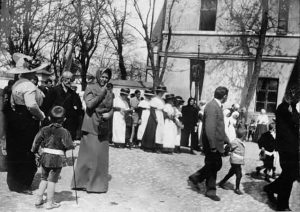These old photos, taken from open Internet sources, give us an idea of how Ukrainians celebrated Easter at the turn of the 20th century – blessing of Easter baskets, church processions, partaking of blessed foods around the Easter table, etc.

In the early 1900s, villagers and townspeople also attended church services, carried their Easter to church for blessings, and took part in the festive procession around the church.

Soviet authorities banned all Easter celebrations, initiating an “implacable battle against the reactionary traditions of the church and the religious dependence of peasants in daily life.” However, many firm believers continued to visit the church secretly.

Teachers were often obliged to stand at the entrance of each church and note the persons that attended. It was the same in schools and educational institutions – children and students were questioned whether their families decorated pysanky, whether their mother baked Easter breads, whether they attended church, etc. – and this information was then delivered to the higher soviet authorities.


In order to “break the will of the Ukrainian people”, villagers and townspeople were forced to take part in so-called “subotnyky” – cleaning campaigns usually organized on Saturdays. They were taken to the country or designated areas in towns and cities, and forced to spend the day cleaning the roads, sidewalks, parks and countryside.
But, traditions have survived, handed down from one generation to the next. For example, on the night before Easter Sunday, the head of the household would make a fire in the hearth. It was believed that fire had a purifying force. Family members would gather dry branches, because “this is where the evil spirit dwells”. Sausage, cheese, eggs, butter, beets with horseradish, salt and Paska Easter breads were carefully laid in a basket and taken to church to be blessed, and joyfully consumed on Easter Sunday….

Easter was and is a great time for children, because they were allowed to ring the bells all day long… and gathered into teams to enjoy various games with pysanky, for example, organizing “egg fights” – knocking the eggs against each other, and whoever had an intact pysanka by the end of the day was proclaimed winner.
Happy Easter to all celebrating Easter by the Julian calendar







